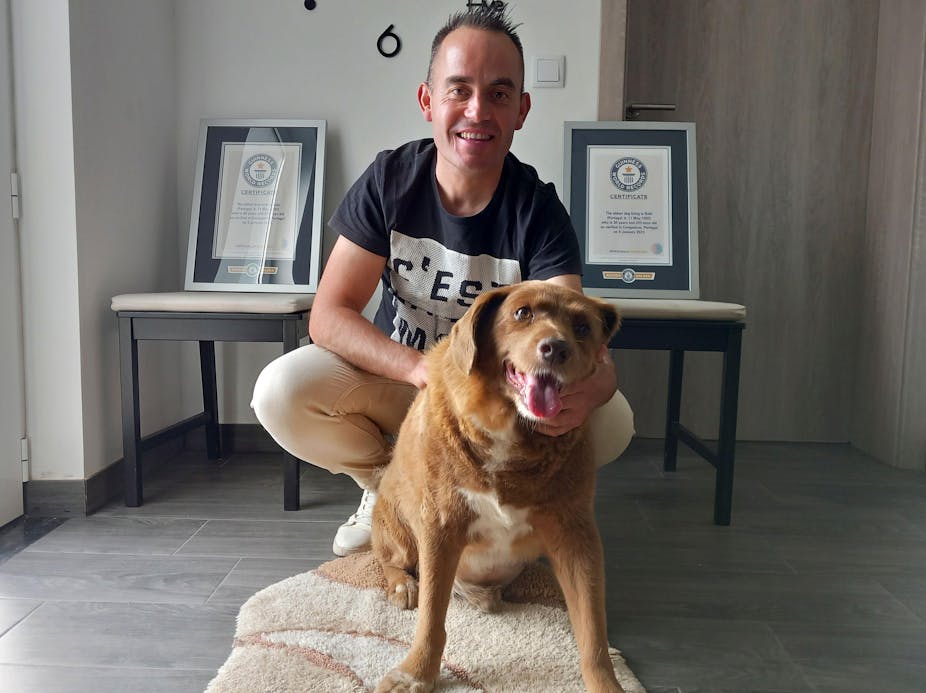If you have ever cared for a pet dog, it is a sad truth that you are likely to outlive them. So it’s no wonder that people may be asking how to increase their pet’s longevity following the news that a dog in Portugal lived longer than 30 years.
The Guinness World Record Holder of the title of World’s Oldest Dog, Bobi, has recently died aged 31. This is an impressive age for any dog. Smaller dogs typically live longer than larger breeds but the average dog will get to around 13 years old before age inevitably catches up with them.
Bobi apparently lived a relatively unrestricted life in the Portuguese countryside, eating the same food as his human caregivers and enjoying free roam of the nearby forestland. His unusual longevity has been attributed to this lifestyle. While there is some debate about Bobi’s actual age, his diet and lifestyle, unsurprisingly, has attracted much attention from canine caregivers.
There is a lot we don’t understand about ageing but there are common factors associated with longevity for many species. These factors seem to help increase lifespans in species as varied as the microscopic worm Caenorhabditis elegans, dogs and humans. This suggests that other species can be useful models in helping us understand our own ageing process.
So, what practical measures can we take to help ourselves and our dogs live as long and healthy lives as possible?
Eat a nutritious diet
Bobi reportedly ate the same food as his owners. But dogs and humans have different nutritional needs. This means that feeding your dog the same food you eat is unlikely to meet their requirements and could even be dangerous.
However, diet does affect ageing. In humans, a diet low in saturated fat and high in fruit and vegetables supports healthy ageing.
For dogs, increased levels of antioxidants support energy generation in the body’s cells and aid learning and brain health in older dogs. These include vitamins C and E, and nutrients such as alpha-lipoic acid (found in red meat and organ meats) and L-carnitine (also found in red meat). These nutrients are typically provided in fortified, prepared dog food.
If you feed your dog a commercial diet, check it is labelled as “complete”. This ensures that if you feed the recommended amount, your dog will be getting all the nutrients at the right levels to meet their needs. Home-prepared dog diets are often deficient in key nutrients, unless they are carefully prepared.

Keep active
Physical activity is often linked to healthy ageing. Studies suggest that dogs living in rural areas and large dogs are more active than their older, smaller and urban counterparts. Interestingly, older caregivers also have more active dogs compared to younger dog owners.
Walking is a simple way to support maintenance of a healthy body weight in dogs and their caregivers, leading to mutual health benefits. Age, size, breed, health and other variables will affect the amount of exercise a dog needs. For example, dogs originally bred to work and be highly active, such as collies and spaniels, are likely to need more physical activity (intensity and duration) than toy breeds such as pugs, who might be happy with a gentle wander around the neighbourhood.
But almost without exception, walking and other activity is good for our dogs. It can also mean that you and your dog are happier, another key factor linked to healthy ageing.
Maintain a healthy body weight
Excess body weight is associated with reduced health and lifespan in dogs and people. Research consistently indicates that a degree of calorie restriction and a lean body weight is associated with increased longevity in a range of species. Somewhat paradoxically, photographs of Bobi suggest that he was carrying rather more body weight that would be considered healthy for a typical dog of his size.
Regular monitoring of your dog’s (and your own!) body weight is a good way to maintain a healthy waistline and support longevity. It is important to know what a healthy body weight and shape looks and feels like for your own dog. Many caregivers fail to recognise what a healthy, lean animal should look like and others underestimate how much excess weight their pets are carrying.
With practice, you can become familiar with a healthy body shape by checking that your dog has a defined waistline when viewed from above, that you can feel (but not necessarily see) their ribs and that their abdomen tucks up when viewed from the side. You can use breed specific resources to understand more about the physical shapes of some dogs.
Feeding your dog a suitable amount to meet their nutritional needs while maintaining a lean body weight can help reduce the chances they will develop painful and distressing conditions such as osteoarthritis.
With some simple dietary and lifestyle interventions, we can make sure our shared lives with our dogs are as happy, healthy and long as possible. Our companion dogs might not reach 31 years old, but we can certainly make mutual longevity an aim.

